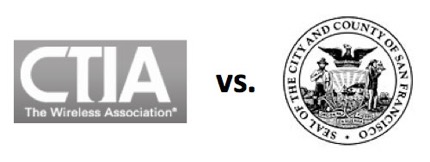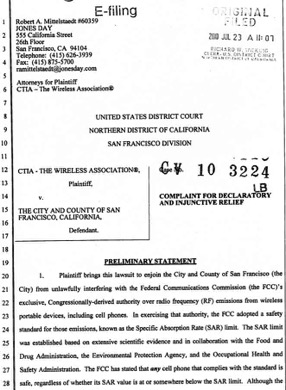CTIA, SF, & SAR: Round 2 - The Craziness Continues

Yesterday, CTIA opened Round 2 of its struggle with the elected government of San Francisco. A press release proudly announced
Today, CTIA-The Wireless Association® filed a lawsuit in the U.S. District Court Northern District of California San Francisco Division to block enforcement of the San Francisco “Cell Phone Right-to-Know” ordinance. The ordinance challenges the Federal Communication Commission’s (FCC) determination that all FCC-compliant wireless handsets are safe by mandating that retailers post Specific Absorption Rate (SAR) values. The ordinance misleads consumers by creating the false impression that the FCC’s standards are insufficient and that some phones are “safer” than others based on their radiofrequency (RF) emissions.
The CTIA complaint filed in federal district court is shown at left and linked to the image. In filing this complaint CTIA has engaged 4 different law firms:
Jones Day - “more than 2300 lawyers around the world”
DrinkerBiddle - “We lead complex and sophisticated business transactions and litigate many of the most important legal challenges that our clients face.”
Wiley Rein - “Broadcasting & Cable has recognized Wiley Rein as a ‘powerhouse law firm.’ “
Kirkland & Ellis - “A law firm serving global clients”
CTIA members:
How much is this costing you?
Is that why you don’t have money for buildout of new systems?
Since voice minutes are actually decreasing due to the growth of smartphones which are much more intensive users of your networks and for which SAR values are much lower, why does this really matter now?
The CTIA Complaint drafted by its 4 pricey law firms states that
“the Ordinance is expressly preempted by Section 332(c)(3)(A) of the Communications Act, which prohibits state-imposed conditions on “entry” to the wireless market, including point of sale ‘warning requirements’ and labeling requirements” (p.3, l.7-9)
A quick review of Section 332(c)(3)(A) finds no mention of “ ‘warning requirements’ and labeling requirements’”.
The complaint states in its opening paragraph:
The FCC has stated that any cell phone that complies with the (SAR) standard is safe, regardless of whether its SAR value is at or somewhat below the SAR limit” (p. 1, l. 27-28, emphasis in original)
Yet later on when it discussed this in depth the only reference it gives to FCC’s safety finding is a URL to the Commission’s Consumer & Governmental Affairs Bureau webpage, not to a finding by the Commission in a decision. The section they quote from that webpage is
The FCC requires cell phone manufacturers to ensure that their phones comply with these objective limits for safe exposure. Any cell phone at or below these SAR levels (that is, any phone legally sold in the U.S.) is a "safe" phone, as measured by these standards. The FCC limit for public exposure from cellular telephones is an SAR level of 1.6 watts per kilogram (1.6 W/kg).
I have trouble going from this FCC staff remark on a web page to the CTIA viewpoint stated about: “The FCC has stated that any cell phone that complies with the (SAR) standard is safe, regardless of whether its SAR value is at or somewhat below the SAR limit”.
CTIA’s ever quotable John Walls said in the press release “The problem with the San Francisco ordinance is not the disclosure of wireless phone SAR values – that information is already publicly available.” Yes now it publicly available, but no thanks to CTIA and its membership. Ten years ago they strongly fought Chairman Kennard on this issue when he sought to follow the UK in making the SAR data readily available to the public. They tried to keep the information as buried as possible within the FCC’s ever chaotic website.
But Mr. Walls, why aren’t you also suing or at





![Validate my RSS feed [Valid RSS]](valid-rss-rogers.png)

